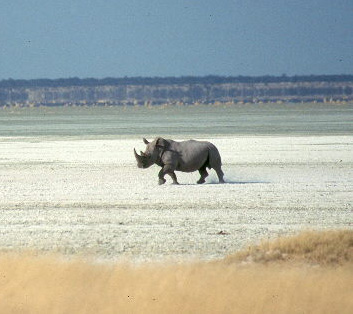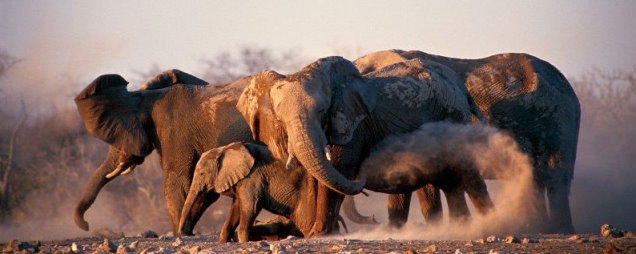Etosha National Park
Etosha Game park was declared a National Park in 1907, and its 22,270 square kilometre area is home to 114 mammal species, 340 bird species, 110 reptile species, 16 amphibian species and, surprisingly, one species of fish. Etosha, meaning "Great White Place", is dominated by a massive mineral pan. The Etosha Pan covers around 25% of the National Park. The pan was originally a lake fed by the Kunene River, however the course of the river changed thousands of years ago and the lake dried up. The pan now is a large dusty depression of salt and clay which fills only if the rains are heavy (and even then only holds water for a short time). The perennial springs along the edges of the Etosha Pan draw large concentrations of wildlife and birds.
Visitors to Etosha Game Reserve can expect to see many buck species, elephant, giraffe, rhino and lions. More fortunate visitors will see leopard and cheetah. There is a network of roads linking the three campsites and subsidiary roads lead to various waterholes.


Traditionally visitors to Etosha have had a choice of three rest camps - Namutoni, Halali and Okaukuejo - that are operated by Namibia Wildlife Resorts. Each camp has tourist facilities such as a restaurant, a shop (selling only basic goods), a motor garage for fuel and basic repairs, and a swimming pool, as well as various grades of accommodation and camping facilities. Non-resident visitors to Etosha, i.e. those residing at one of the many private lodges and hotels around Etosha, can stop off at these camps for rest, recreation, and refueling. All three camps have floodlit waterholes, two of which provide excellent night game viewing. Rhino and elephant are often seen at the waterhole at Okaukuejo, while the newer waterhole at Halali is fast attracting more wildlife. Because the quality of accommodation and service is higher at the private establishments, which can be found outside the Etosha Park, visitors often choose to stay in them rather than within the camps. Many of these establishments offer private game drives, either in their own game reserves or in Etosha Park itself. That said, September 2008 heralded the opening of Onkoshi Camp, the first development inside the park in several decades, which offers an environmentally friendly, luxury experience.

Visitors should note that the park is only open from sunrise to sunset. Outside of these hours, visitors either have to be in one of the camps, or completely outside the park - or sleep in their cars, surrounded by sharp-toothed prowlers and the sounds of the bush at night! Unlike many other African game reserves, Etosha does not have its own guided safaris. For those wanting a guided experience the options are either staying at one of the private lodges around the park which offer daily game drives, joining a scheduled guided safari to Etosha (usually starting in Windhoek), or custom making a private guided safari through the park.


Traditionally visitors to Etosha have had a choice of three rest camps - Namutoni, Halali and Okaukuejo - that are operated by Namibia Wildlife Resorts. Each camp has tourist facilities such as a restaurant, a shop (selling only basic goods), a motor garage for fuel and basic repairs, and a swimming pool, as well as various grades of accommodation and camping facilities. Non-resident visitors to Etosha, i.e. those residing at one of the many private lodges and hotels around Etosha, can stop off at these camps for rest, recreation, and refueling. All three camps have floodlit waterholes, two of which provide excellent night game viewing. Rhino and elephant are often seen at the waterhole at Okaukuejo, while the newer waterhole at Halali is fast attracting more wildlife. Because the quality of accommodation and service is higher at the private establishments, which can be found outside the Etosha Park, visitors often choose to stay in them rather than within the camps. Many of these establishments offer private game drives, either in their own game reserves or in Etosha Park itself. That said, September 2008 heralded the opening of Onkoshi Camp, the first development inside the park in several decades, which offers an environmentally friendly, luxury experience.

Visitors should note that the park is only open from sunrise to sunset. Outside of these hours, visitors either have to be in one of the camps, or completely outside the park - or sleep in their cars, surrounded by sharp-toothed prowlers and the sounds of the bush at night! Unlike many other African game reserves, Etosha does not have its own guided safaris. For those wanting a guided experience the options are either staying at one of the private lodges around the park which offer daily game drives, joining a scheduled guided safari to Etosha (usually starting in Windhoek), or custom making a private guided safari through the park.

G & G